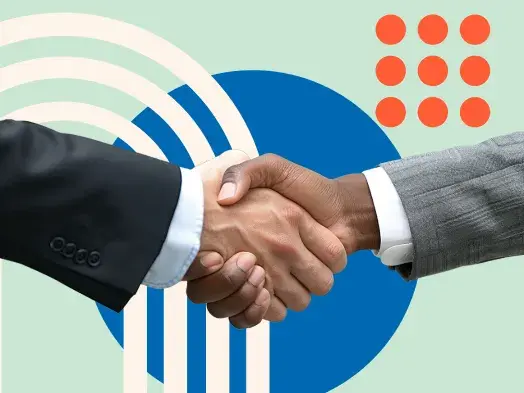In this article, I’m going to share what I’ve observed from partnering with, studying, and simply being in close proximity to these high-performers — how they plan, how they think, and how they execute on their vision.
Whether you’re a sales leader wondering why your recent hires haven’t quite worked out, or a sales rep who’s been stuck in the middle of the pack, unsure why you haven’t reached your full potential yet, this article is for you.
Table of Contents
- 5 Essential Sales Personality Traits
- How to Improve Your Sales Skills
- Tips for Selling Authentically
5 Essential Sales Personality Traits
1. Coaching Mindset and Developmental Focus
Most people are in survival mode, running from meeting to meeting, without pausing to ask:
- What’s working?
- What’s not?
- Where’s the gap?
Often, the gap is a skill gap, but the only way to know is to stop and reflect. And even then, knowing isn’t even half the battle. Self-reflection is not easy. It’s vulnerable. But it’s also uncommon.
I’ve learned that the best sellers treat their self-development journey with the same vigor and intention they bring to prepping for a big client meeting or running a high-stakes internal call. They’re not dabbling. When they commit to something, they’re all in. And they’re willing to do the work.

During his keynote speech at our last Untap Your Sales Potential mastermind, Brandon Fluharty pointed out that the top earners — the million-dollar reps — are always people who have been through a lot.
They’ve faced adversity head-on, and it has shaped them into people who can thrive under pressure and high expectations. They were willing to learn from mistakes and setbacks and use those situations to push themselves forward.
Because Brandon is so process-oriented, it got me thinking about other sellers I know who’ve cracked seven figures. There’s a common thread here, too: They all have a framework they follow. It’s not random. It’s repeatable. And it gives them clarity and reassurance so they don’t have to reinvent the wheel every day.
2. Authentic Leadership and Vulnerability
Out of the hundreds of speeches, manager talks, and motivational hoorahs I’ve heard over the years, only a few truly stuck with me. And the ones that did weren’t about tactics or quotas — they were about people.
One I’ll never forget happened with Mike, one of the best directors of sales I’ve ever worked with. He gathered our whole team into a glass conference room right in the middle of the office where everyone could see us. Then he just … shared. Deeply. He opened up about losing his father, how that grief shaped him, and how it became his why. No slides. No agenda. Just raw honesty.
We all cried together in that room … for about four hours. And afterwards, we went out to celebrate at a cozy Italian restaurant. That moment changed everything for me. It showed me firsthand the power of vulnerability in leadership. The managers I’ve most enjoyed working with are the ones who don’t posture — they show up with their whole selves, unafraid to be open and real.
Mike’s vulnerability gave us all permission to open up about our own stories — to talk about our purpose, our pain, and our drive. And that shift? It changed our culture. We stopped operating as individuals and started functioning as a real team.
Sales is a roller coaster, and no matter where you work, it’s going to feel like a grind at times. And yet, we often trick ourselves into thinking we’re alone, like no one else could possibly understand what we’re going through.
But when we all bared our souls, we built a level of trust that was unshakeable. We ended up becoming one of the top-performing teams in the company. And it all started because Mike went first.
3. Emotional Intelligence and Active Listening
I’ll never forget this moment — about a month ago, our CEO, who’s usually full of brilliant ideas, strategies, and advice, did something different. He just listened. Uninterrupted. He asked me about all the concerns, frustrations, and challenges I had been facing over my nine months in the role.
Because he’s given me so much autonomy and trust, our biweekly skip-level meetings were often more of a check-in than a deep dialogue. But that day, he held space in a way that caught me off guard. He didn’t try to fix everything or jump into solutions. Just being heard made my stress melt away. I walked out of that conversation feeling reinvigorated, recommitted to our mission: Helping sellers heal and unlock their full potential by doing the deep inner work to overcome self-limiting beliefs.
Emotional intelligence (EQ) has been a huge part of my journey. It’s helped me:
- Grow a meaningful social media following.
- Write dozens of blog posts.
- Interview 200+ podcast guests over the past eight years.
- Most importantly, learn to love myself.
Practicing active listening has transformed my relationships, especially with my wife. Instead of falling into a “me versus you” mindset, I’ve learned how to create win-wins. EQ is as much about understanding yourself as it is about understanding others.
And to be honest, self-understanding was the harder part for me. I used to surround myself with people constantly, partly because I was actively avoiding being alone with my own thoughts. But the turning point came when I committed to the deep work.
That work looked like:
- Journaling every day.
- Reflecting on the” 7 Morning Power Questions” by Tony Robbins.
These questions became a game-changer. Answering these simple questions helps you build deeper self-awareness. Instead of constantly being in survival mode, you’ll start to operate from a place of abundance. You’ll feel grounded. You’ll stop chasing. You’ll show up with presence.
Try them. Right now. I promise you won’t regret it.
Tony Robbins’ 7 Morning Power Questions
- What am I happy about in my life right now? What about that makes me happy? How does that make me feel?
- What am I excited about in my life right now? What about that excites me? How does that make me feel?
- What am I proud of in my life right now? What about that makes me feel proud? How does that make me feel?
- What am I grateful for in my life right now? What about that makes me grateful? How does that make me feel?
- What am I enjoying most in my life right now? What about that do I enjoy? How does that make me feel?
- What am I committed to in my life right now? What about that makes me committed? How does that make me feel?
- Who do I love? Who loves me? What about that makes me feel loved? How does that make me feel?
4. Adaptability and Willingness to Change
This one can be really difficult — especially if you’re used to a certain style of living.
I was fortunate to feel like the mayor of LinkedIn NYC at one point. I was constantly active: leading the Asian LinkedIn Alliance, volunteering for career panels, and showing up for all the after-work socials. I thrived on that energy. During my time there — at one of the most competitive companies to get into — I built my calendar around in-person meetups and happy hours I often hosted with 30+ attendees each month.
Then the pandemic happened.
When everything shifted to 100% virtual, I won’t lie — it rocked me. I had a bit of an identity crisis. I felt out of sync with how I used to show up.
But what I’ve learned is that the best reps — the ones who stay on top — roll with the punches. They don’t make excuses. They adapt.
So when I hear people say, “Man, the good old days were nice, weren’t they?” — I get it. I’ve been there. But at the same time, I also believe that we have to read the room, see where the world is heading, and adjust.
The moment I finally let go of wishing things were different, I began to see the beauty in what was. Virtual conferences, once strange to me, became a space where people from all over the world could open up, connect, and be vulnerable. That, to me, is just as real — maybe even more so — than the rooms I used to stand in.

5. Strategic Vision and Effective Communication
The best sales reps are clear and concise. One of the top reps I worked with at TriNet, named Sean, stood out for how effectively he communicated. He consistently closed high-margin deals with minimal discounting — because he fully understood and believed in the value we were providing.
Think about luxury brands like Celine or Christian Dior. Are they 10x more valuable than other fashion brands? Maybe not in materials, but they are in the experience and perception.
When I visited Paris for our anniversary, I remember stepping into the Dior store and instantly feeling pampered and taken care of. The associate didn’t just sell products — he told a story. He made recommendations based on what would genuinely suit us. I had no intention of buying a necklace, but the vision he painted made me feel seen. At that point, I had never owned anything designer, and yet, I walked out with that necklace. To this day, when I wear it, I still feel special.
Another point: Since much of communication is nonverbal, it’s often less about what you say and more about the energy you bring to the conversation. Think about your favorite influencers — they have a way of speaking that feels natural, almost like chatting with a friend.
That casual tone is powerful: The less a call feels like a sales pitch, the more likely it is you’ll have a real, meaningful conversation. And even when someone puts up a wall, sharing something personal can open the door for deeper connection, as it helps people lower their guard.
In sales, you’ll always encounter prospects who aren’t open-minded, and that’s okay. Not everyone will be a fit, and not every conversation will be your cup of tea. The key is to not take it personally and be willing to move on quickly. Like Ted Lasso says, having the memory of a goldfish helps keep you resilient.
How to Improve Your Sales Skills
1. Implement regular self-assessment practices.
Start a journaling practice.
Every Monday morning, I start my weekly practice by journaling for 30 minutes about what went well and what could be improved. This gives me greater self-awareness and space to process everything that’s on my mind.
Freeform journaling works best for me because every day brings different thoughts, and this practice helps me reflect on what I’m stressing about, what I’m excited for, and what’s been weighing on me.
Become aware of your “flow” activities.
When I’m truly present and connecting with a client, time seems to fly — it feels effortless and fulfilling. On the flip side, when I spend time chasing prospects who clearly don’t have the budget, mindset, or alignment with what we offer, it drains me.
It’s a good reminder that alignment matters more than volume.
So why do I sometimes work on low-value activities? I think it’s because we’re wired to take the path of least resistance. But I’ve noticed that when I spend even five minutes researching and developing a thoughtful point of view before reaching out, I may make fewer dials — but I get a much higher response rate.
Determine when, where, and why you might be procrastinating.
Have you ever found yourself burning the midnight oil, not because you’re overloaded, but because you procrastinated?
A simple journaling habit can help uncover the root cause. Sometimes, it’s just a matter of poor planning. And that’s okay. Don’t beat yourself up — just treat it as a data point to improve for next time.
Build strategic relationship networks.
It’s cliché to say “your network is your net worth,” but there’s truth behind it. In today’s digital age, where so many aspects of business are virtual, interactions can often feel more transactional than relational. As a result, many people have lost the ability to build networks in an organic and intentional way.
My Method
Step 1: One practical way to maintain meaningful relationships is to create an Excel sheet of people you want to stay in touch with strategically. Categorize them as A, B, or C connections:
- A: People who will always have your back.
- B: Strong connections worth nurturing.
- C: Contacts who may come and go over time.
This exercise will help you appreciate the dynamic nature of relationships. People come and go — and that’s okay. Cherish those who stay, and be grateful for the moments of connection you’ve had with others.
Step 2: Next, build a simple touchpoint framework. Ask yourself: “How do I want to stay in touch — through coffee chats, quick Zoom calls, or thoughtful check-ins every quarter?”
A great mentor can dramatically accelerate your growth. Sure, you could figure things out on your own, but why not shorten the learning curve and avoid mistakes others have already made?
I had a mentor who climbed the corporate ladder rapidly — and I didn’t realize at first what a super connector he truly was. He had someone in his Rolodex for virtually every problem I brought up. Because he consistently added value to his ecosystem, he opened doors to opportunities most people can’t even dream of.
What many forget is that building and maintaining a network takes effort and energy. It’s just like going to the gym — you won’t always feel like doing it, but the long-term benefits are worth it.
I regularly reach out to over 100 people I want to keep in my orbit throughout the year. It’s not always easy, but investing in community and connection gives me purpose, and that’s something no algorithm or automation can replace.
Establish gold standards for key activities.
For a good seven months, I was banging my head just calling every lead that came through the website. I was barely able to hit my number of 40 meetings a month.
However, once I slowed down and was more thoughtful about which leads to pursue, I made fewer dials — but the dials were more concentrated.
This shift required me to be organized and articulate my top five personas and their detailed POVs. It forced me to think and reflect on all the good clients who have come through and what common things they dealt with.
Last week, my manager planted this seed that I couldn’t quite shake off. He said, “It’s interesting how you always end up with 40 meetings by the end of the month. If you raised your standards, you would be able to hit 70 meetings a month.”
At first, I was like, “No way, how would that be possible!” But that’s a mindset problem. I needed to think through what 70 booked meetings a month would look like. I had to get extremely focused, process-driven, and say no to non-generating activities.
Identifying a gold standard for your key activities is where it starts.
Tips for Selling Authentically
Tip 1: Connect personal values with organizational goals.
It’s important to slow down and think about your personal values, and to be able to connect them to what you do every day at work.
The “5 Whys” exercise is helpful for delving deeper into what excites you on Monday mornings — but it requires vulnerability.
“5 Whys” Exercise
I’ll give you an example of the exercise below, which I filled out for myself.
- Why do I need to hit my revenue goal of $1.8 million at Untap Your Sales Potential? Well, because it allows me to maintain my standard of living. I get to go to cool vacation spots and eat at some of my favorite restaurants.
Commentary: The first level is kind of basic. It’s what everyone thinks about when asked why they have a job: to maintain their lifestyle, to provide for their family, etc.
- Why is that important? I get to eventually retire in Hawaii and spoil my wife and kids, and bring them a lot of happiness in the memories that we cherish together.
Commentary: The second “why” allows you to think about it, but doesn’t get to the root of your personal values.
- Why is that important? I want to live a life that I never had growing up. I felt like we didn't have enough, and I became envious of friends who seemed to have well-off families and got to do all of these cool things.
Commentary: Okay, now we are making progress. At this point, you are getting to something deep-rooted.
- Why is that important? I want to see who I become in the process of putting myself out there and doing the deep work required to get to the next level. This way, I can build the skills to have the mental fortitude to weather the storm and take care of my family.
Commentary: This is a much better “why” that gets to the holistic level that will carry me through the dark times.
- Why is that important? I want to serve my clients and give prospects who join us at Untap Your Sales Potential an experience like the one I had. I want them to learn to love themselves deeply and not fall into the trap of being ashamed of how they are showing up and instead be proud of the work that they are doing and how it serves their communities.
Commentary: This is the real “why” — the one that will keep me going after phone hang-ups and rejections when I’m in the day-to-day of my role.
Tip 2: Embrace transparency and direct feedback.
Getting and receiving feedback is always difficult at first. But once you get used to it, you realize it's just a way to get better and not to take it so personally.
There is an important difference between taking the feedback as a data point versus internalizing it and beating yourself up about it. Just because you are at a certain competency doesn’t mean something is wrong with you.
The key is to implement the right feedback.
Tip 3: Don’t be afraid to address the topics everyone else is avoiding.
I’ve noticed that in corporate environments, people often avoid the hard conversations, but let’s be real. Staying silent is still saying something.
Crucial conversations are the ones you’ve probably been putting off. I used to be notorious for that (and to be honest, I still catch myself doing it sometimes). But here’s the thing — those uncomfortable convos? They always find a way back. If you don’t address them, they’ll linger in the back of your mind and create unnecessary weight.
The key is to bring it up in a way that resonates and sticks.
If you sense that a client is struggling — maybe they’re going through something personal that’s impacting how they’re showing up — don’t just power through the script. Try something like: “It feels like something might be going on. Would you be open to sharing what’s top of mind for you?”
That level of presence goes a long way. Sometimes, it helps to share a story about another client who went through something similar.
As a salesperson, your role isn’t just to pitch. It’s to be a connector — to ensure the right conversations, support, and resources are happening so the project (and the person) moves forward.
Getting Started
Emotional intelligence, curiosity, vulnerability, and active listening make up the DNA of an effective salesperson.
I grew up with limited resources — living off government assistance, and working jobs that barely paid above minimum wage. I’ve been in the trenches. I know what it’s like to wonder if you’ll ever catch a break.
But I also know this:
- It’s possible to 5x or 7x your income if you’re willing to put in the work.
- If you have the right mentors.
- If you keep an open mind.
- If you stay hungry and humble.
- I was able to do it. And so can you.
When you master these skills — not just the technical ones, but the human ones — you won’t just make more money. You’ll build a thriving, fulfilling career.
And remember: the moment you think you’ve got it all figured out? That’s usually a red flag. That means you’re not open to feedback or growth anymore. So stay curious.
Editor's note: This post was originally published in January 2016 and has been updated for comprehensiveness.
Sales Traits




%20(1).png)
![5 best sales skill assessments for hiring top talent [+ scorecard]](https://53.fs1.hubspotusercontent-na1.net/hubfs/53/Operation-everest-sales-skill-assessment-1-20250912-2016267.webp)
.jpg)



![What Type of Salesperson Are You? [Quiz]](https://53.fs1.hubspotusercontent-na1.net/hubfs/53/SELLING%20STYLE%20(1).jpg)

